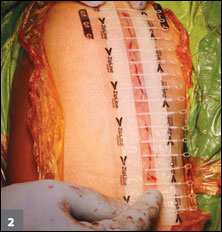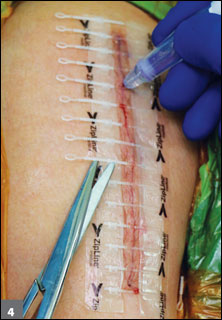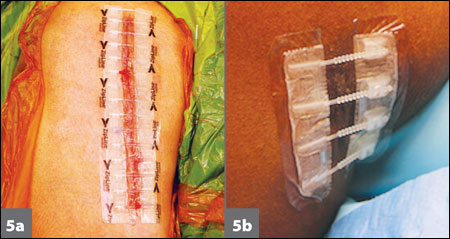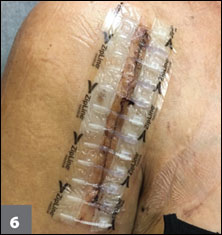Noninvasive device helps with elective, traumatic shoulder incision closure
Although wound closure is often considered a routine part of orthopedic surgery, complications such as surgical site infection, wound dehiscence and scarring can occur. When considering surgery, patients often express concern about the cosmetic results of the incision. Traditional methods of skin closure that use staples, nonabsorbable running or interrupted sutures, or intradermal absorbable sutures have low complication rates, but these can cause microtrauma to the epidermal skin and microvascular blood supply. Complications associated with staples and sutures include wound dehiscence, infection, wound inflammation, discharge and drainage, abscess formation, skin-edge necrosis and allergic reaction. Pain associated with suture and staple removal is commonly reported and can make patients anxious about postoperative care and may lead to suboptimal patient satisfaction. The time it takes to perform the closure is also a concern for physicians, with closure using staples reported to be seven-times faster than closure using sutures.
A device for skin closure has been developed that attempts to address these concerns (Figure 1). The noninvasive Zip Surgical Skin Closure (Zipline Medical) has been used by physicians in such other disciplines as general surgery, cardiothoracic surgery and dermatology. The Zip Surgical Skin Closure is a noninvasive closure device for the epidermis that avoids the need for staples, sutures, butterfly closures or other final skin closure devices. This device is designed to distribute the surgical incision tension uniformly throughout the skin closure and to flex with the patient’s motions while potentially reducing the risk of hypertrophic scarring because of the protection it provides from shear forces, which some research has shown may result in increased scarring.




Dermatologic, cardiothoracic and general surgery studies suggest the use of this noninvasive closure device reduces the risk of wound complications, improves the appearance of the postoperative scar, reduces shear forces at the incision surface and is a faster method of skin closure than suturing. The closure device and other tape-based closure techniques have proven more effective at holding the wound intact and providing uniform mechanical support compared with sutures and staples. In a study that compared closure of sternotomy incisions in cardiothoracic patients, closure using this device and technique was performed, on average, more than 4 minutes faster than subcuticular wound closure. This finding was supported by a dermatology study in which similarly sized 3-cm skin lesions were removed from the extremities and trunk, and comparisons were made regarding the time associated with using the noninvasive closure device vs. sutures. The average times for placement and removal, respectively, were 1.8 minutes and 8.2 seconds with the closure device and 3.9 minutes and 58 seconds with epidermal suturing.
In a dermatologic study, Gorsulowsky and a colleague reported patients’ average comfort rating was 3.6 out of 4 with the closure device and they had minimal discomfort during removal. The investigators also discussed the ease of application and removal of the device. Although they did not perform a cost analysis, the incision closure device costs $40 and has a shelf-life that is comparable to suture. The faster removal and application time associated with the noninvasive closure device may offset its cost. It is unknown whether the incidence of surgical site infection is lower with the closure device; however, the absence of retained foreign material may reduce infection risk.
Surgical technique
We have used this noninvasive closure device in traumatic and elective cases, applying it routinely for shoulder arthroplasty, biceps tenodesis, proximal humerus fractures and trauma cases without substantial soft-tissue injury. It can be used for any incision type in which there is minimal tension on underlying subcutaneous tissue. Situations in which it would be inadvisable to use the device include when traumatic or irregular incisions are present, when an incision is made in a high-tension closure area and in areas of the skin with hair or high oil production.

The device is available in sizes that range in length from several centimeters to 14 cm. The back of the device has two parallel adhesive rows that are covered before removal with several “straps” that are perpendicular to the wound and run between the adhesive components. Each strap runs through a tensioner, which sets the applied tension through each strap and is cut flush with the tensioner after the proper tension is applied (Figure 1).
Wound closure is completed in a typical layered fashion so the superficial layer is closed using evenly spaced 2-0 Vicryl sutures (Ethicon) with good apposition of the skin. Instead of using a running 3-0 Monocryl suture (Ethicon) for the subcutaneous layer, we place the closure device to approximate the skin edges with minimal tension.
The incision is dried while the closure device is measured against the wound and cut to the appropriate size. It is advisable to place one strap on the device past the incision on either side of the wound to ensure the tension is not entirely concentrated directly over the incision. The hypoallergenic adhesive backing on the closure device is uncovered and placed with the central clear space aligned symmetrically over the incision (Figure 2). The straps are tightened sequentially with minor tension applied initially. Then each strap is retightened appropriately (Figure 3). Any excess straps are cut to be flush with the tensioner, and skin adhesive is applied to the incision to help seal it from the external environment (Figure 4). Skin adhesive can be applied before the excess straps are removed so that strap removal occurs while the adhesive dries, which makes the process more efficient.
A small sterile gauze pad and protective adhesive are applied to the incision for wound coverage after the skin adhesive has dried (Figure 5). Depending on the type of surgery performed, this dressing may be removed on postoperative day 3. At this point, patients may be allowed to shower if no drainage is present. The skin closure device is removed about 10 days to 14 days after surgery. Patients can remove the device at home if they are unable to attend a postoperative appointment (Figure 6).
In the past year, we performed about 360 closures using the noninvasive closure device and had no related postoperative complications. We experienced several minutes of time saved per case during wound closure using the closure device, as well as time savings during clinic visits when sutures and staples would normally have been removed.
Our patients have responded positively to their experience with the device. They appreciated being able to shower with the closure device, the ease of wound covering and of removing the device compared with sutures or staples. The incisions closed with this device have healed well with good cosmesis at final follow-up for a variety of incision types (Figure 7).


Pitfalls
We have not observed complications, such as wound dehiscence, skin irritation or infection in the past year when using this device. Complications reported in cardiothoracic research include only minor skin discoloration and exfoliation.
Potential issues that can arise during application of the device involve over-tensioning and under-tensioning, both of which may be corrected easily at the time of application. When a strap is over-tightened, the tension can be released with the help of an Adson forceps. The strap can then be tightened appropriately.
When we began using these closures, we attempted closure of portal sites in arthroscopic cases, which was unsuccessful because drainage from the incisions often prevented the closure device from adhering firmly to the skin.
This noninvasive closure device is our current device of choice because of its ease of use, high degree of patient satisfaction, low complication rate, cosmesis of closure and speed of application. Although we currently use it for all our open surgery incisions, we do not use it for arthroscopic portal closures because of poor adhesion.
- References:
- De Maria E. World J Clin Cases. 2015;doi:10.12998/wjcc.v3.i8.675.
- Frishman GN, et al. J Reprod Med. 1997;42:627-630.
- Gorsulowsky DC, et al. Dermatol Surg. 2015;doi:10.1097/DSS.0000000000000399
- Graham DA, et al. Knee. 2000;7:239-243.
- Levi K, et al. Cureus. 2016;doi:10.7759/cureus.827.
- Liew SM, et al. Aust N Z J Surg. 1993;63:131-133.
- Mitwalli H, et al J Am Acad Dermatol. 2016;doi:10.1016/j.jaad.2015.08.004.
- Patel RM, et al. Orthopedics. 2012;doi:10.3928/01477447-20120426-16.
- Shetty AA, et al. J Orthop Surg (Hong Kong). 2004;doi:10.1177/230949900401200210
- Singh B, et al. Eur J Orthop Surg Traumatol. 2006;16:124-129.
- Stockley I, et al. Ann R Coll Surg Engl. 1987;69:76-78.
- Tanaka Y, et al. Ann Thorac Surg. 2016;doi:10.1016/j.athoracsur.2016.03.072.
- For more information:
- Matthew J. Albrecht, PA-C, can be reached at Johns Hopkins Shoulder & Sports Medicine, Department of Orthopaedic Surgery, 10700 Charter Dr., Suite 140, Columbia, MD 21044; malbrec3@jhmi.edu.
- Matthew Binkley, MD, can be reached at 8 Charles Plaza, #1907, Baltimore, MD 21201; email: mbinkle1@jhmi.edu.
- Uma Srikumaran, MD, MBA, can be reached at Department of Orthopaedic Surgery, The Johns Hopkins University, 601 N. Caroline St., Baltimore, MD 21287; email: editorialservices@jhmi.edu.
Disclosures: Albrecht, Binkley and Srikumaran report no relevant financial disclosures.
